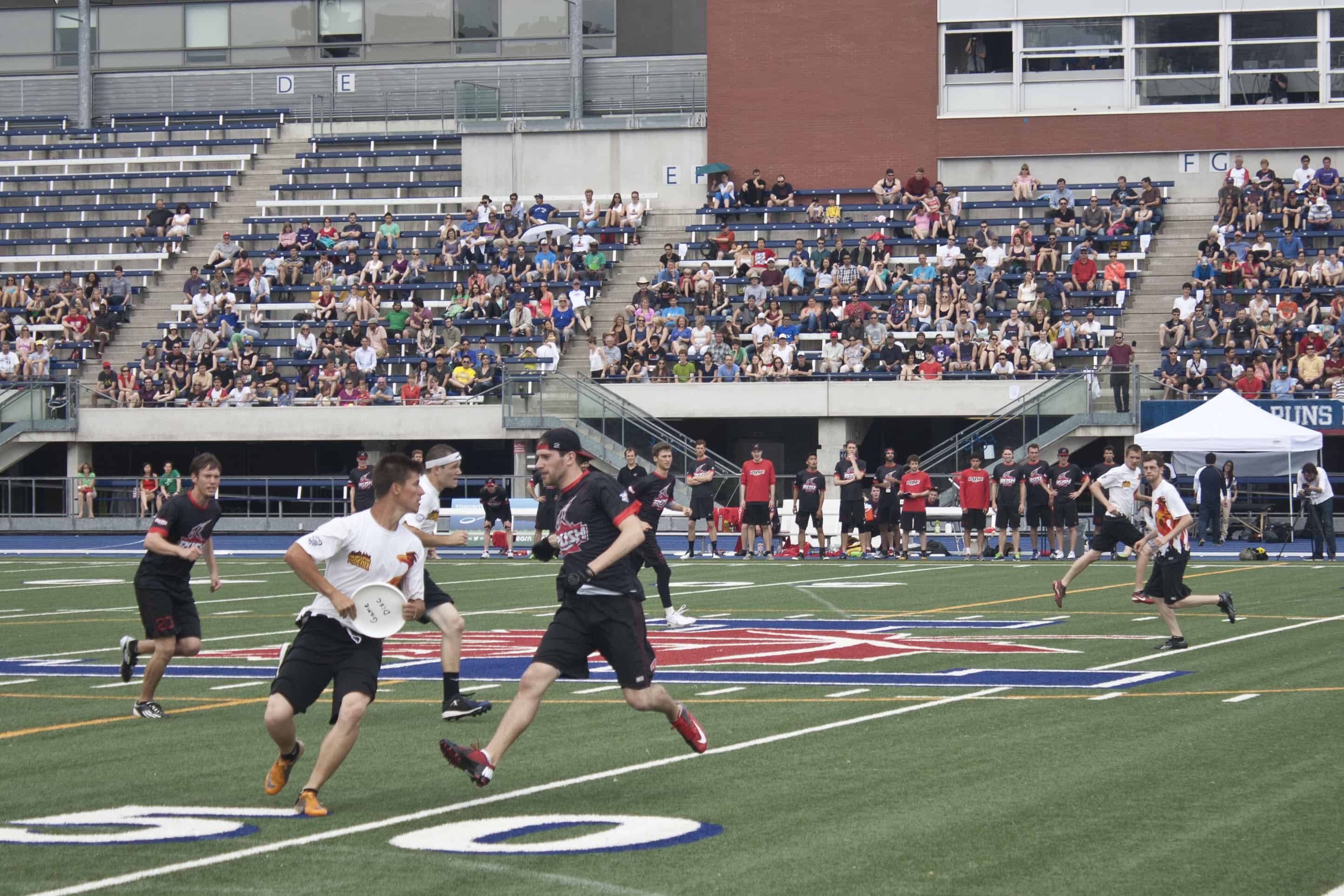The Toronto Rush, Canada’s first professional Ultimate Frisbee team, extended its undefeated streak to eight games Saturday evening with a 28–18 win over the Philadelphia Phoenix at Varsity Stadium. The win left the Rush in first place in the American Ultimate Disc League (AUDL) eastern division with 10 points, the only undefeated team.
Ultimate is a seven-a-side, non-contact sport, in which stationary players advance a disc downfield to running teammates, who must catch the disc in the end zone. Players who catch legal passes are not permitted to run while holding the disc. Any incomplete passes or turnovers result in a loss of possession.
The last meeting between the two teams resulted in a narrow 26-25 victory for the Rush over the Philadelphia squad, currently in second place in the AUDL east. But this game was a much different affair; wind gusts provided some initial difficulties in the game as it often changed the trajectory of the disc, and, while both teams started strong (the Rush only had a two point lead after two quarters), an incredible offensive display saw Toronto outscore the Phoenix 18–10 in the second half.
“It was pretty humid and windy today which made it a gruelling effort. It rained too for parts of the game, but overall it was a good effort,” said the Rush’s Geoff Powell following the match.
Eamonn Pinto, who has played Ultimate for nine years, echoed the sentiments of his teammate: “We had to win. It was a statement game. I think we’ve now proven that we deserve to be where we are.”
Central to the success of the Rush in its inaugural campaign has been co-founder Mark Lloyd, who leads the team in goals (18) and points (14). Lloyd has played the sport competitively for over a decade, competing in numerous tournaments across North America and was part of the Canadian team that won the 2010 World U-23 Ultimate Championships in Florence, Italy.
When asked by his father Rob Lloyd, a Silicon Valley executive, what he intended to do following his graduation from university, the younger Lloyd expressed a desire to find a more competitive outlet for his Ultimate talents. So, his father bought him a professional team.
Many of the Rush players have other jobs outside of Ultimate. They receive a small league-mandated baseline stipend at the end of the season, based on ticket and merchandise sales, and also have all of their travel, conditioning, and training expenses covered.
The Rush has worked to secure a partnership with Mississauga-based marketing company Cosmos Sports. At a Media Day held at Varsity Stadium in April, Cosmos Sports president Cary Kaplan told those gathered that he hoped that the team would help to “change the sport in North America from a participation sport to a spectator sport.”
The popularity of Ultimate is growing globally. The International World Games Association, which operates under the International Olympic Committee, has acknowledged Ultimate as a world sport, capable of competing for bronze, silver, and gold medals. Participants hope that it will one day feature as an event at the Olympics.
“At least once a week, there will be a highlight from an Ultimate game that features in an ESPN top 10 reel. It is definitely a sport that is getting a lot more serious attention,” noted Ultimate Experience Television (UxTV) colour commentator Chucktown.
The Toronto Ultimate Club has over 10,000 members, making it the third largest club in North America. Kelly Johnson, a production assistant for UxTV’s live broadcast of Ultimate matches, notes that Toronto’s Ultimate culture has played a large role in the success of the Rush so far.
“In the United States, there are a lot of different subcultures of Ultimate. In Toronto, you don’t really have that. The partnerships that the Rush has with youth teams in the community are great. The players are often hosting clinics, which will prove to be important in the long run,” she explained. “In the States, the sport is mostly popular in coastal areas. It still has a slight fringe element to it.”
Conveniently situated close to public transportation and in the middle of a university filled with young students who are part of Ultimate’s key demographic, the 5,000-seat Varsity Stadium has also played a crucial role in the success of the Rush. Games feature pregame events, halftime shows (usually involving a game between two youth Ultimate teams in Toronto), and concessions.
Anita Comella, assistant dean of the Department of Kinesiology and Physical Education of the University of Toronto, spoke at the media day and expressed her desire to see the sport grow and to increase participation not only among students, but also among faculty members.
The Rush’s first home game saw a crowd of 2,293 people, breaking the AUDL’s record attendance record.
“It’s very exciting,” says Pinto, adding, “I’ve been more than impressed with the feedback from the Ultimate community and many new fans that I’ve met. Varsity Stadium is a great venue.”
As for what’s next for the Rush, UxTV’s Chucktown says the sternest tests will likely come in the postseason. “There are some good teams in the Western Division. I’d like to see how the Rush fare against a team like the Radicals,” he added.
The Toronto Rush is set to face off against the New Jersey Hammerheads on June 9 at Varsity Stadium.


